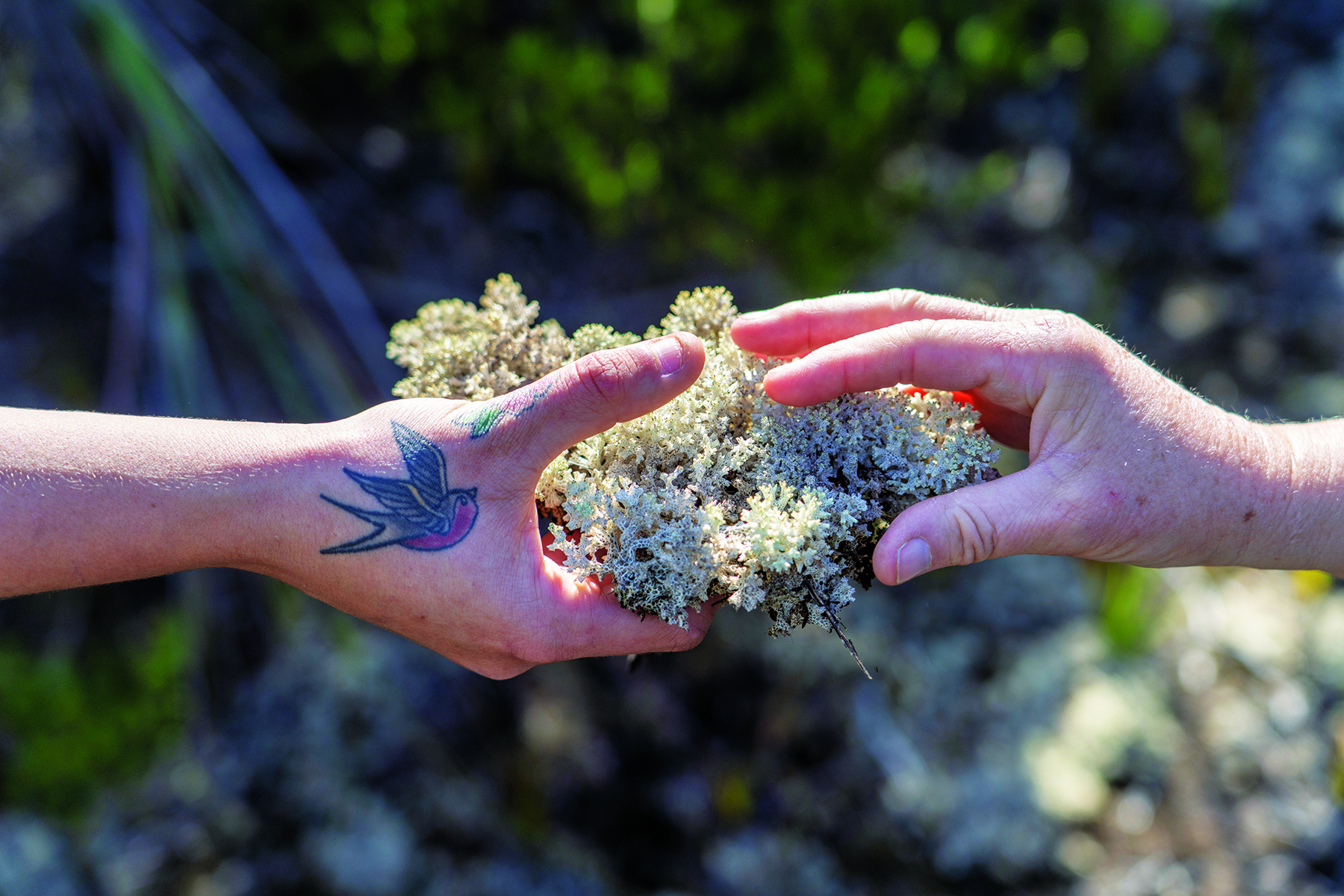“The difference between us mob and your average tour guide,” explains Uncle Hank Horton, “is we open ourselves up, bare bones and all.” He’s seated among Elders, guides and guests around a long table enjoying morning tea at the Aboriginal Elders Council of Tasmania in Launceston, where wukalina (Mt William) Walk begins and ends. “We don’t skirt the true history,” he adds. “You’ll learn about what it means to be Aboriginal and why being on Country is so important to us. We like to say that our tour is not a tour, it’s more a journey.”
The walls of this 1927 building are adorned with framed shell necklaces and quilts that speak of the music, muttonbirding, shell collecting, cultural foods and returned service people of truwana (Cape Barren Island). Rows of monochrome portraits of Elders past and present, by photographer Ricky Maynard, overlook a yarning circle – where speaking and listening from the heart is practised.
Hank, an Aboriginal community member, is lead guide on the Walk. Beside him palawa woman Sharon Holbrook, who prepares food for every trip, introduces herself as “Stolen Gen”. Her grandson Jacob Holbrook, a palawa and Wiradjuri man connected to northern Tasmania and northern New South Wales, has guided the Walk since its 2017 inception and is support crew for the journey leaving today.
Also joining us are: Carleeta Rose Helen Thomas, a pakana woman of north-eastern lutruwita (Tasmania) who’s been with the Walk since she was 17; and cultural knowledge holder Jam Graham-Blair, a Trawlwoolway and Plangermaireener pakana from lutruwita, who is a conservation ecology student at the University of Tasmania. “Today I’m pretty excited to get back to the homelands,” Jam says.
When palawa Elder and founder of the Walk Uncle Clyde Mansell arrives, Hank refers to him as “our Clydey”. “We’re very lucky this man had the vision to create wukalina Walk,” Hank says. Born on Flinders Island, Clyde has personal experience of last century’s Cape Barren Half-Caste Reserve and Tasmania’s assimilation policies. He is Chair of the Aboriginal Elders Council of Tasmania, was Chair of the Aboriginal Land Council of Tasmania for 20 years and NAIDOC Person of the Year in 1990.
First Nations owned and led, wukalina Walk is a four-day, three-night experience of culture and hiking “We’ve been able to now provide the chance for non-Aboriginal people to get a feel for what we mean when we talk about cultural connection,” Clyde says, explaining that the Walk also gives young First Nations people the opportunity to be on Country and tell their story. “It’s about the lives and the place of Aboriginal people. It’s as much about today as anything.”
Joining us are five other guests, who, like me, are non-Indigenous Tasmanian residents with more to learn than we can possibly imagine. Tilly, a gardener, was raised in rural Tasmania, where “there was physical evidence of the original occupants as well as the recorded interactions between [First Nations people] and settlers on the property”. When later studying fine arts at university, she became intrigued by the work of Aboriginal and Torres Strait Islander artists.
Also joining us are Helen, a counsellor, and her partner Ian, a retired historian. “What always shocks me,” Ian says, “is how welcoming and generous people are after all that we have done.”
Together we board a minibus, wave goodbye to Clyde and Sharon and head north-east out of Launceston. For a while we’re alongside kanamaluka (River Tamar), and once the city is behind us, the views are of farmland and an occasional township. At one stage, the road passes right through an ochre pit.
Shortly after leaving, Hank circulates a map called “Tasmanian Aboriginal Nations, family groups, and their homelands before European invasion”. It’s from a 1989 Tasmania Department of Education book series called Living with the Land. Shapes of colour denote the land and sea Country of the nine nations of lutruwita. It also lists the names of the 48 ancestral groups across which 14 distinct languages were spoken. Words salvaged from those have been used to construct the composite language palawa kani.
I notice Carleeta is travelling with her copy of the recently published palawa kani dictionary, already dog-eared and packed with post-it notes. As the dictionary explains, the words palawa and pakana mean Tasmanian Aboriginal person. “Palawa is a southern word,” Jam says. “Pakana is a northern word, which comes from the language group most Tasmanian Aboriginal people descend from, but both mean the same thing and we often use them interchangeably.”
Hank also passes around a convict artist’s impression of Mannalargenna, a key figure in the Aboriginal resistance following Britain’s invasion of lutruwita. Mannalargenna is bare-chested, wears a necklace of kangaroo tail sinew and ochre and holds a paperbark fire stick, and his beard and shoulder-length hair are coated with red ochre. “We’re able to link our family tree right back to that bloke there,” Hank says. “His land was north-east, where we’ve got our camp set up.”
We cross the Pipers River to Trawlwoolway Country, where there’s a shift in the ecosystem and Hank’s historic interpretations and personal stories interweave inextricably. Hank was born before the 1967 referendum, in which Australians voted overwhelmingly to count Aboriginal people in the national population. He was raised on truwana and later near Deloraine on mainland Tasmania. There, he recalls being caned for having an argument with a high school teacher “when she tried to tell me there were no Blackfellas in Tasmania”.
From the car park in wukalina (Mount William National Park) it’s an easy 2km hike through bushland dominated by melaleuca and banksia to the highest point. At 216m above sea level, this timeworn
granite summit supports lichen, orchids and, as scat suggests, Tasmanian devils. Northwards we can see tayaritja (Furneaux Islands), which 12,000 years ago were elevated features of a land bridge.
“When the muttonbird are migrating,” Hank says, gesturing east to where sky meets ocean, “you can look over there and see a solid black line just above the horizon – stretches as far as your eye can see.” His sweeping arm traces the memory with an outstretched finger, left to right, from the edge of truwana, over the top of larapuna (Bay of Fires) and towards Antarctica.
Thousands of generations of our guides’ Ancestors saw those clouds of birds. While non-Indigenous archaeologists estimate it has been more than 42,500 years, the First Nations peoples of lutruwita know they’ve belonged to this place and been its caretakers since Creation. “Imagine what it was like for Mannalargenna seeing those sailing ships coming out of nowhere,” Carleeta says. “Not knowing what’s going on and not knowing whether they’re staying or going.” That was in 1803 – lutruwita’s version of 1788.
The Black War lasted from the 1820s to 1832. Mannalargenna died at Wybalenna, which means Black Man’s House, on Flinders Island in 1835. By the time Britain’s Colony of Tasmania was officially established in 1856, on unceded lands, the First Nations population – estimated to have been between 4000 and 30,000 at the time of invasion – had been savagely reduced to a few hundred people, and it didn’t stop there. What occurred was genocide.
There’s unexpected drama in the topography of the islands visible from wukalina. Carleeta was the last baby to be born in the truwana hospital. On her mother’s side she’s a descendant of pakana woman Nimerana, from truwana. On her father’s side, Carleeta descends from Fanny Cochrane Smith, who was born at Wybalenna in “It was one of the best things growing up over on Cape Barren,” she says. She can’t wait to return to the islands in late March for birdin – the cultural practice of muttonbirding – with the family.
On the 9km hike from there to camp the guides encourage us to try lomandra plant flesh and hazelnut-like bracken furls. They show us how to rub bracken sap onto our skin for insect bites, cuts, stings and burns and demonstrate how coral fungus retains water. “We like to tell people our land is our Woolworths, our Coles, our Bunnings, the chemist,” Carleeta says.
Dry sclerophyll forest gives way to heathland where kunzea owers and yamina (grass tree) stems stand proud in their fountains of leaves. Wombat and wallaby graze on marsupial lawns, where soil moisture is much higher than in the surrounding vegetation, and sea eagles cruise overhead. Creeks are high from recent heavy rains and parts of the track are flooded with tannin-brown water slick with tea-tree oil.
Beautiful as it is, this cultural landscape is sick from neglect. “A lot of our plants need that cool burn to regerminate,” Carleeta explains, as she scrapes back leaf litter to expose smothered topsoil. Black yamina trunks are concealed under layers of still-attached dead leaves. Cultural burning is fundamental to the custodians of lutruwita and this Country is yearning for their care. The Tasmania Fire Service is on board with the reintroduction of cultural burning but Tasmania Parks and Wildlife Service is dragging the chain.
“My Aunty always reckons if the smoke makes you cry then you’ve got something to cry about, so just let it out,” says Jam, who leads the Welcome to Country on our first night at camp.
Our bellies are full of grilled muttonbird, oven roasted lamb, homemade salads and Tassie wines. To Jam, muttonbird tastes “like the ocean”. But the omega-3-rich oil extracted from its stomach is apparently far more intense: Hank tells us his brother, Never Never, jokes that after the spoonful of muttonbird oil their mother regularly dispensed you’d go outside and “lick the dog’s arse” because that tasted better.
Jam layers black peppermint gum branches on the fire, explaining that this ceremony introduces us to the Ancestors. “When I invite you to put your leaves on, soak up this smoke with intent, breathe in the fresh medicine and breathe out any worries you might be carrying,” he instructs us.

“Really love the aroma of that smoke,” murmurs a guest. It swirls into the clear night sky as we step forward one by one. “Ya pulingina nina-mapali-tu,” Jam says. Hello and welcome to you all.
Krakani lumi, meaning resting place, is a standing camp, between dunes and lagoon, designed and built exclusively for wukalina Walk. An elongated timber building has distinct spaces for reclining, dining and washing. Gauze-doored sleeping huts with dome ceilings were inspired by traditional bark homes. And wooden boardwalks join everything together.
Around the firepit, Carleeta goes into greater detail about birdin, using words I’ve never heard before such as scun and gurrie. An uncle can pluck a bird in seconds and she shows us a video of her skinning. She rarely looks at her hands; they know what to do.
“I often refer to the movie The Castle,” Hank says, as people start heading off to their huts, “when [a character] says ‘it’s the vibe of the place’.” A chorus of frogs and muted crashing waves lulls us to sleep under cosy doonas and thick, warm throws made of wallaby skin.
The light of a new sunrise floods krakani lumi’s large domed lounging space. A few guests are up having the day’s first cuppas while others sleep in. After breakfast we’re guided to the northern end of the beach where pakana families have always shared freshly harvested seafood such as abalone, crayfish, periwinkle, limpet and weriner. Far larger shells lie in layers from previous times when there was freedom to ensure everything belonging to these coastlines was in balance.

“Today our mob is still coming along, collecting our shell food from here, sitting back there and starting to use this cultural living place again,” Hank explains, as we walk around barefoot. He says the palawa community prefers that people stop using archaeological terms such as midden. “We’re not in the past; we’re still here.”
On return, Carleeta finds a washed-up shark egg with the embryo’s tail moving. Hypervigilant oystercatchers zip around the beach. Hank picks up seaweed and demonstrates how pakana women caught crayfish by bunching air-filled kelp tips into a buoy and dangling meat from a loose tail of seaweed; when the buoy moved they knew the crayfish was taking the bait.
On a large cuttlebone he finds on the beach, Hank points to the strong line of black ink marking a time of distress followed by survival. The afternoon is spent at camp. Carleeta sits in the dome, wearing a wallaby skin cloak, stringing shells and weaving. Hank makes clapsticks beside the fire while Jam mixes ochre and paints his skin in the sunshine. We’re welcome to try everything. On some wukalina Walks they make water carriers of bull kelp. These and other cultural practices directly connect pakana to each other and to their Ancestors.
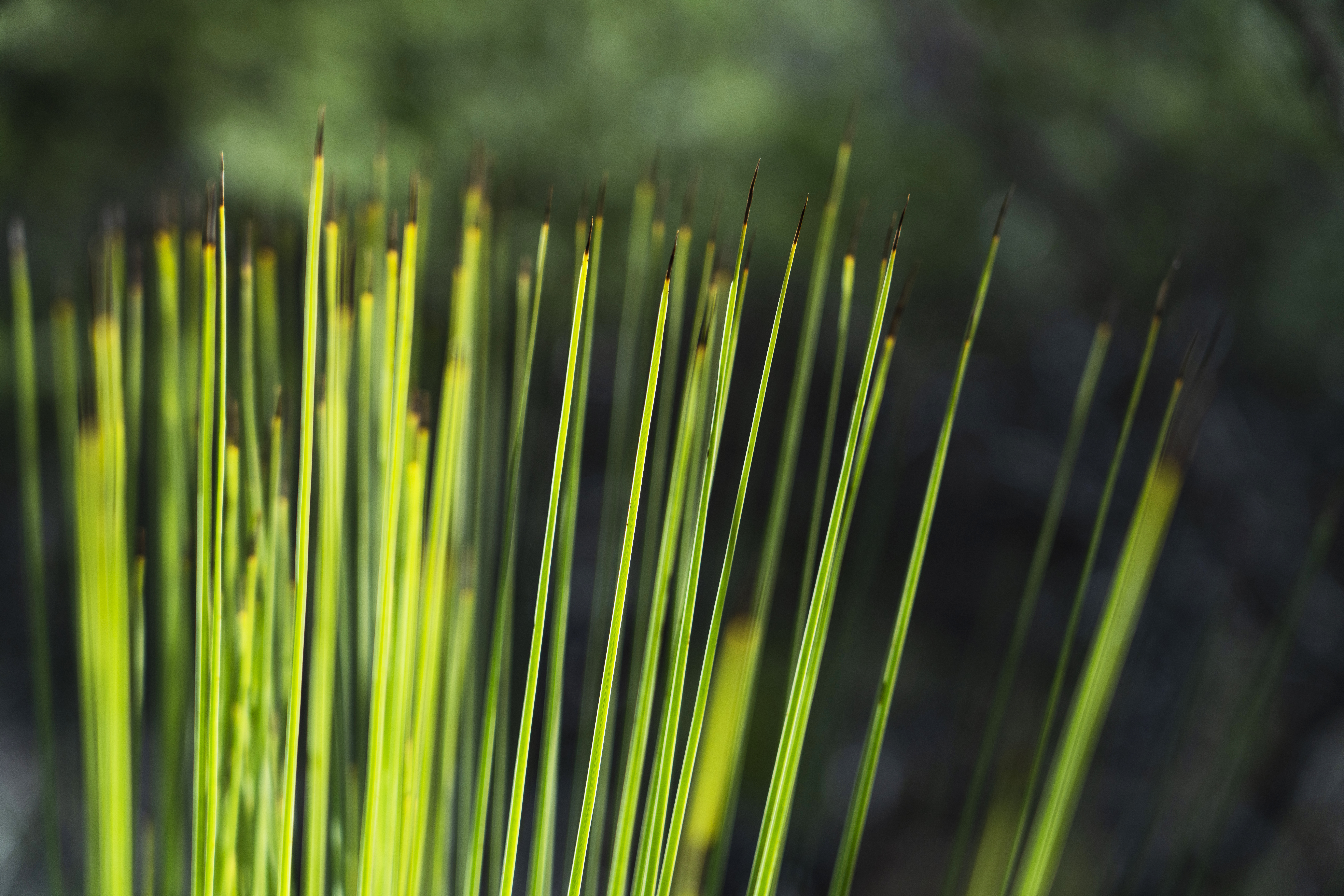
“A lot of people ask me ‘what made you different?’” Hank says as he cuts away some bark. “When I went to school, it wasn’t just the colour of my skin that made me different…it was the culture that I lived at home”. Rather than going to a restaurant for dinner they’d go out and snare a kangaroo. During holidays, he and his brother Nev would camp at the snare run of their grandfather Pop Jittles, in kooparoona niara (Great Western Tiers).
Hank, now a senior knowledge holder, started Tasmania’s first Aboriginal tourism business – Jahadi Tours. He sits on boards, runs education programs and writes interpretations for walking companies. He raised daughters connected with their culture and his teenage grandson, Jessie, is already training to guide wukalina Walk.
The day neither flies nor drags. We do so much yet still have plenty of time to sit, talk, listen and laugh. “Blackfella time,” Hank calls it.
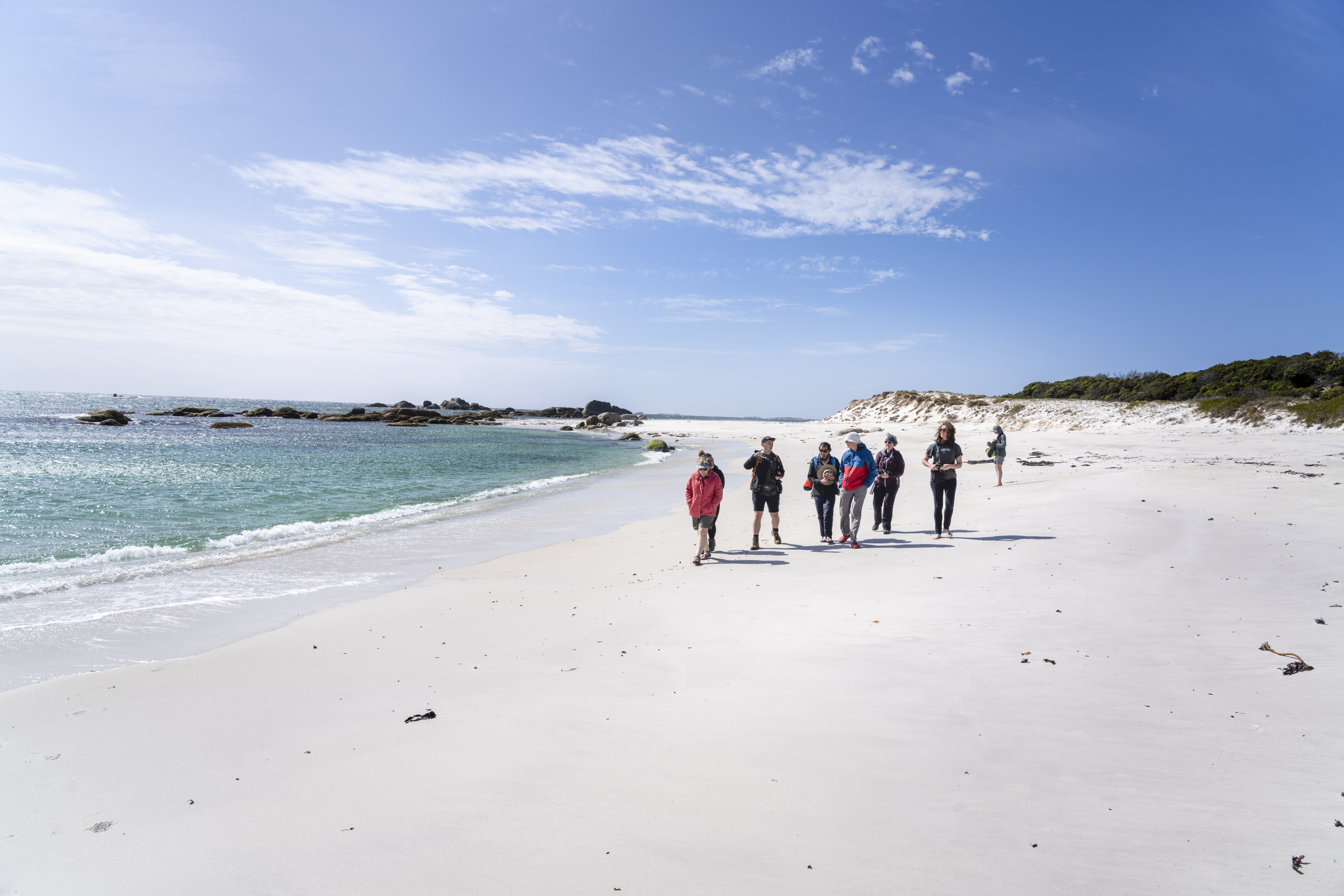
Today Jam and Carleeta wear shell necklaces. Jam’s is a mixed strand of black crows from larapuna, peppermint gumnuts from “down south”, brown-striped spiral shells called turks gathered from Sandy Bay near his home in nipaluna (Hobart), and white shells from a necklace of his late grandfather that broke at a festival. “I kept the shells thinking I’ll restring it and do the same pattern,” he says, “but I decided to use some of the shells to create this new necklace.”
Carleeta’s was made by an Elder, Aunti Corrie Fullard, and bought from a Tasmanian gallery by environmentalist Bob Brown. Carleeta explains that, after he and his partner, Paul, came on wukalina Walk, Bob wanted to return the necklace to the community so he posted it to Carleeta. “I wear this necklace every single walk,” she says of the exquisite strand of tiny maireener shells draped in three long loops.
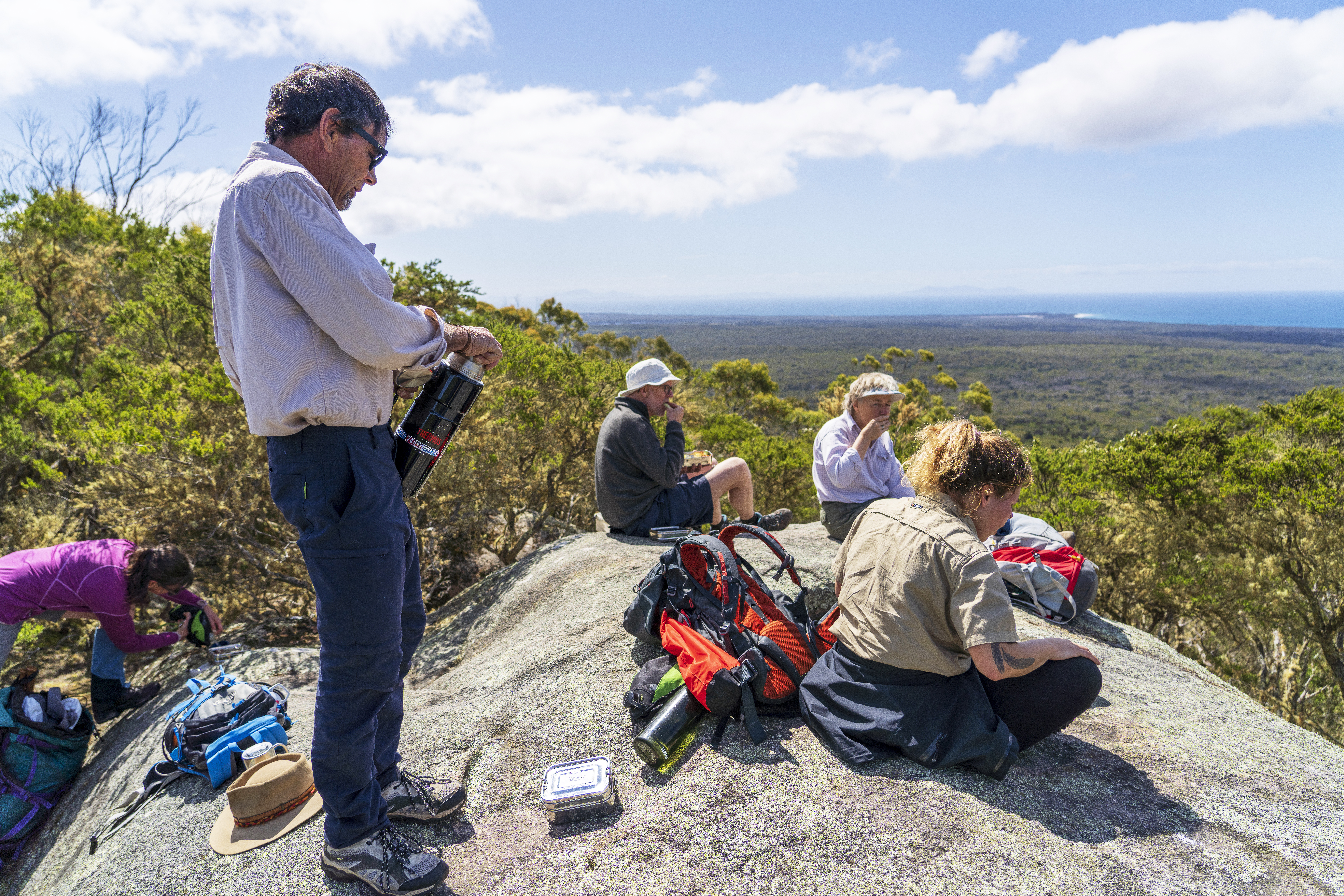
While teaching me an S-twist stitch, Carleeta talks of her Ancestors’ relationship with the Bass Strait islands, which were only seasonally visited before European sealers arrived. The sealers recognised pakana women as extraordinary hunters and engaged their services. Many had their hands cut off by sealers as they tried to later return to longboats and subsequently drowned. Others were kept, against their will, on islands such as truwana and never saw their families again. “You have to think how strong these women would have been,” Carleeta says as she hands me a delicate king maireener shell she’s tied to a twisted string of dried river reed.
“You share your knowledge with us so openly,” Tilly says to Hank, Carleeta and Jam the next day over morning tea. “You’re offering not just a guided trip but friendship… you’re sharing your life with us.” It’s the third day, which means 17km of beach walking then a night in a renovated lightkeeper’s cottage, yet we’ve already come so far on this journey together. By late afternoon we’ll reach the most northern end of larapuna, named Bay of Fires when early Europeans counted more than 200 camp fires and cultural burns in the landscape. There is so much proof of life and loss in that name.
I can only imagine what a toll it takes on guides to revisit the brutal history of this place week after week. Yet when I ask them each, separately, how they manage they all respond with variations of the same answer.
“Being on Country is healing.”
